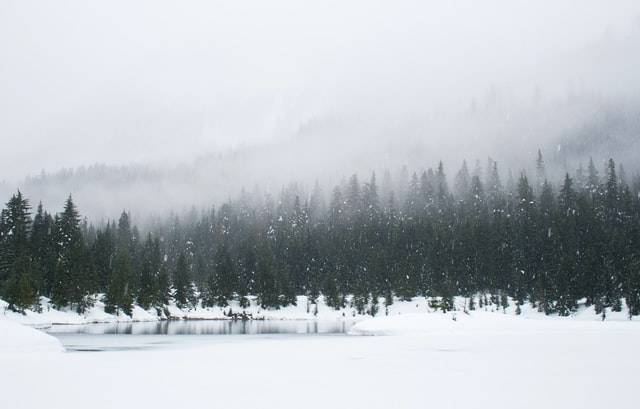Table of Contents
As the temperatures begin to drop, it’s time to consider what you need to do to keep your water systems running in top condition. Depending on where you store your water softener, you may need to take extra steps to protect.
How Can Cold Weather Harm My Water Softener?
To understand how cold weather damages your water softening system, it helps to visualize how the machine functions. A water softener filters out minerals like calcium and magnesium that harden your water with residue. With these minerals in your water, you may experience a buildup in your pipes that decreases water pressure and may damage household appliances — such as coffee makers, dishwashers, ice makers and any other machine that uses water.
Water softeners collect hard water in a mineral tank full of resin beads that are negatively charged with a sodium ion. Because sodium and calcium are positively charged ions, this process enacts an ion exchange that traps the unwanted minerals in the resin beads. Any water that passes through the tank becomes mineral-free soft water.
Without proper protection, cold weather could cause substantial damage to your water softener. In frigid temperatures, unattended water in your softener can freeze. When this happens, you risk the potential for burst pipes that can cause flooding and damage to your house and possessions.
it from the cold. Find out how to keep your water softener from freezing and maintain it over the winter.
What Happens When a Water Softener Freezes?
Water softeners rely on various connections for smooth operation. If temperatures dip below 32 degrees, it’s possible for pipes and distribution tubes to crack or separate. These breaks may result in water escaping the system where it can flood your home.
Checking on water softeners during winter can save you from a huge mess and costly repairs. You’ll want to make sure that water can move through your system freely. If your water softener is used throughout the year, ensure surfaces, tanks, inlets and outlets are free of ice. You’ll want to winterize your water softener to stop system components from working harder than they have to during the coldest points of the season.
Six Common Signs Your Water Softener Is Frozen
Contacting a professional is recommended if you suspect your water softener is frozen. If you’re unsure about your water softener status, look for the following signs:
- Your water softener is cold to the touch.
- Ice is accumulating around water softener surfaces.
- Pipes and connections leaving the water softener are coated in ice.
- Blocks of ice are lodged in drainage lines.
- Your water softener runs louder than normal.
- Water softener electronics power off on their own.
What Are the Dangers of Frozen Water Softener?
Homeowners often forget about water softeners during winter because they sit in basements and garages. Your water softener is as fragile as other home appliances in freezing temperatures. Ignoring our winter water softener safety advice can result in a complete system replacement.
Water treatment system equipment will expand and contract in the winter. If you forget to insulate connections or power down the system for multiple years, pipes can grow brittle and eventually break. Some might think that since most water softeners contain salt, tanks and components are unable to freeze. However, if conditions are below 32 degrees, it’s possible for your water softener to stop working.
The biggest concern of a frozen water softener is bursting pipes. Water covering the walls and floors near a water softener will freeze quickly, creating thick sheets of ice. This requires you to perform a large cleanup job in the heart of winter. Also, bursting pipes are concerning from an electrical standpoint. Something as simple as a small leak could create a fire if water droplets reach electrical sockets and wiring behind walls.
Tips to Prevent a Water Softener From Freezing
How do I keep my water softener from freezing? Consider the following tips when preparing a home water softener for the colder months:
1. Keep it warm
If you use your water softener year-round and keep it in a relatively warm area, it may just need extra heat to get through the winter. Winterizing your water softener is, simply put, not letting it freeze. For the best results, maintain a temperature of at least 32 degrees Fahrenheit to avoid any part of the system freezing.
Position a space heater near your water softener during cold periods of time to maintain a constant flow of warm air around the system. If you’re away on vacation, consider leaving your central heat on at a low level to facilitate a warm environment for your softener. A slight increase in your heating bill is pennies compared to the thousands of dollars it may cost to repair frozen pipes and a flooded basement.
For extra protection, you can also insulate (winterize) your pipes and equipment with a specialized wrap.
2. Drain the tank
If you don’t plan on using your water softener during winter, you can drain its tank to prevent freezing. This is best practice with outdoor water softeners. This will help both your water softener tank and drain hose from freezing over. Your local Culligan Water expert can answer any questions you have about winterization requirements.
3. Keep the water running
Water softener connections have a harder time freezing when water is moving. If you’ll be away from home for a few days, think about leaving the kitchen faucet dripping slightly. This trick can save you from dealing with water softener pipes bursting.
4. Install insulation
Visit your local home improvement store to pick up some insulation material that will trap heat. Cut it to fit around your pipes and water softener, then use zip ties to hold it tight. Insulation will help keep your water above 32 degrees Fahrenheit and prevent a pipe burst.
5. Monitor daily
The best way to prevent damage to your water softener is to monitor it every day. Check for leaks, drips or other buildup signs on cold days so you can act on any problem quickly before substantial damage occurs.
6. Unplug the system
When you’ll be away for periods, unplug your system to prevent frozen pipes and backflow issues. Unplugging your water softener minimizes the chances of electrical problems and indoor messes when you return from a ski trip or vacation. Remember to drain connecting tanks to prevent freezing.
7. Keep garage doors shut
Some homeowners have water softener installations inside the garage. It’s vital that your equipment stays in an environment above 32 degrees. Space heaters cannot do their job if you leave the garage door open. Close your garage door as soon as you leave the home for consistent system performance.
Do You Need to Winterize Your Water Softener?
A water softener will need winterization in environments where the temperature drops below 32 degrees Fahrenheit. If you’ve placed your water softener in a heated room, you can continue your usual maintenance routine. However, you may want to winterize your water softener if you keep it:
- In an unheated indoor environment, such as a garage
- At a property that you don’t use during the winter
- In your unheated home when you leave for an extended time
Preventative Measures for Water Softeners
It’s a good idea to have a trained professional look over your water softener, especially if you’ll have it drained and disconnected for winter. This season is usually an appropriate time for a technician to assess common wear and tear parts such as pistons, screens and seals across your system. Additionally, changing out system filters and pre-filters is recommended before reconnecting your device in the spring.
How to Winterize a Water Softener That You’ll Keep Using
Learning how to winterize a water softener is simple. You can prepare your water softener system for freezing temperatures quickly with the right materials. Visit your local hardware store to find pipe insulation wrap that will fit around your water softener connections. You can fasten the materials around pipes using heat-safe tapes, cables or zip ties. For a closer look at the process, follow the five-step guide below:
- Move to your water softener.
- Take the insulation wrap and cut it so that it fits securely around pipes.
- Place the insulation wrap around one pipe. The wrapping should cover both sides.
- Secure the materials in place using your preferred tape or cable.
- Repeat the process for each pipe running to and from the water softener.
How to Winterize a Water Softener You Will Shut Down
In some cases, shutting down a water softener is the best move for the winter. This choice primarily applies to vacation homes or cabins that you leave unattended for weeks or months at a time. Disconnect and drain your water softener using the following ten steps:
- Turn off the water supply.
- Release pressure in the softener by using a kitchen or bathroom faucet.
- Remove the softener from the bypass.
- Remove the valve from the tank.
- Drain the water from the collection tank using a siphoning device.
- Allow any remaining water to settle at the bottom of the tank. Wait about five minutes.
- Drain the rest of the water in the collection tank.
- Unplug the device to power down the system.
- Disconnect any remaining inlets and outlets from the softener.
- Place covers over inlet and outlet openings to prevent dirt or insects from getting inside the tank.
Call on Culligan Water for Your Water Needs
When you need water softener maintenance, repair or salt, count on your local Culligan Water expert to handle the job. They know how to service any system on the market, so we welcome owners of all water softeners to call on us for help. For questions about winterizing your water softener – give us a call!
To schedule a visit from Culligan Water, call us at 717-697-0657 or make an appointment online.

